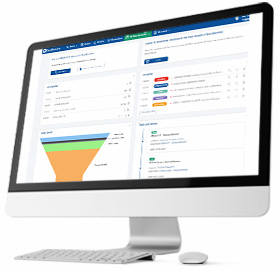13 October 2023
Converting website visitors into buyers requires a strategic approach that focuses on optimizing the user experience, building trust, and encouraging action, although getting those visitors to your website in the first place is key.
With millions of searches completed every minute, the challenge for companies is to be found quickly and easily by the right audience. As a B2B company, you can use SEO, content and landing pages to attract potential customers.
You can also promote your products or services and position your brand using a respected B2B marketplace such as the Kompass Business Directory. To your benefit will be utilising their global reach and the detailed product & service categories that will drive more relevant buyers, looking to purchase, to visit your website.
Once on your website, here are some effective tactics to help you convert those visitors into buyers:
- Is your Value Proposition Clear and Compelling: It is vital that you clearly communicate the unique value and benefits of your products or services on your website. You need to highlight what sets you apart from competitors and why visitors should choose your business. Use persuasive messaging, compelling headlines, and concise descriptions to capture the visitor’s attention and generate their interest.
- Think User Experience: How easy is it for visitors to navigate your website, find relevant information and contact your business? Make sure you optimize your website with the user experience in mind. It needs to be responsive, load quickly, and be intuitive to navigate. It is also helpful to simplify the buying process by reducing the number of steps required to make a purchase or contact your business.
- Call-to-Action (CTA) Optimization: Place clear and prominent calls-to-action throughout your website to guide visitors towards the desired action, such as making a purchase or contacting you. Use action-oriented language and compelling visuals to encourage clicks. Test different CTAs and placements to find what works best for your audience.
- High-Quality and Persuasive Content: Create informative and engaging content that addresses the needs and pain points of your target audience. Use persuasive language, storytelling, and customer testimonials to build trust in your brand. Incorporate relevant keywords to improve search engine visibility and attract qualified visitors.
- Social Proof and Testimonials: Display customer testimonials, reviews, case studies, and success stories on your website to build meaningful credibility. Highlight positive feedback and demonstrate how your products or services have helped others. Social proof that illustrates the benefits can greatly influence buying decisions and alleviate concerns.

- Trust Signals and Security: Incorporate trust signals on your website, such as security badges, SSL certificates, and payment logos, to reassure visitors that their information is secure. Clearly communicate your privacy policy and data protection measures. Display trust-building elements, such as awards, affiliations, or customer satisfaction guarantees.
- Personalization and Targeting: Leverage data and technology to personalize the user experience based on visitor preferences, behaviour, or demographic information. Show relevant product recommendations, personalise content based on their interests, and use dynamic pricing or promotions to create a sense of exclusivity.
- Effective Product Presentation: Use high-quality product images and videos to showcase your offerings. Provide detailed product descriptions, specifications, and customer reviews. Enable zoom or 360-degree views to give visitors a closer look at your products. Make it easy for visitors to add items to their cart or wishlist.
- Abandoned Cart Recovery: Implement strategies to recover abandoned carts and encourage visitors to complete their purchase. Send automated follow-up emails with personalized offers or reminders to nudge them towards conversion. Offer incentives like free shipping, discounts, or limited-time promotions to incentivize action.
- Remarketing and Email Marketing: Utilize remarketing techniques to reach out to visitors who have shown interest in your products but have not made a purchase. Display targeted ads or send personalized email campaigns to remind them of your offerings and encourage conversion. Use email marketing to nurture leads and provide valuable content that drives them back to your website. Make sure you keep your customer data up-to-date – you can use tools such as Kompass EasyBusiness to refresh your business data.

- Provide Good Customer Support: Make it easy for visitors to contact you with questions or concerns. Offer multiple channels for support, such as live chat, email, or phone. Respond promptly and provide helpful and personalized assistance. Positive customer experiences can lead to repeat purchases and referrals.
Remember to continuously analyze and optimize your conversion strategies. Monitor website analytics, conduct A/B testing, and gather feedback from customers to identify areas for improvement and refine your approach. By implementing these tactics, you can increase the likelihood of converting website visitors into loyal buyers.
It’s also important to bear in mind, that to grow your business both locally and abroad, you need to make sure that your company can be found. By adding your company to the Kompass Business Directory, we can help you to do this and as a result, your company will gain the benefit of being part of a truly global B2B marketplace.









Comentarios
No Comments